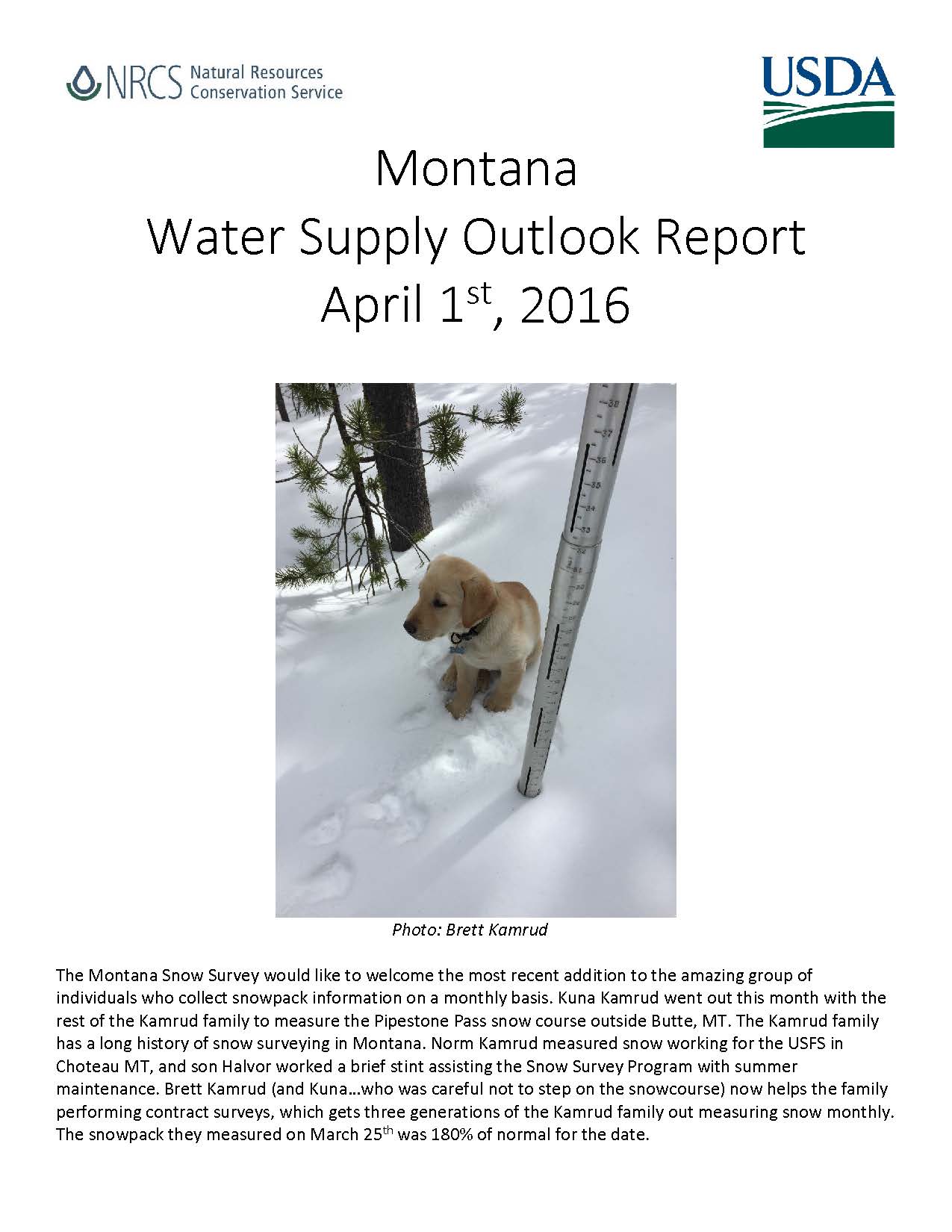Montana Water Supply Outlook Reports
If you wish to start receiving the Montana Water Supply Outlook Report please contact Lucas Zukiewicz at 406-587-6843. Please specify whether you would like to receive an email notification when the report is available. If you have issues with downloading the report please contact us and we can help you get a copy.
These documents require Adobe Reader. For best results, save the document to your computer before opening.
Water Supply Outlook Reports will be published on the fifth business day of each month (Jan-June).
Water Year 2016
Click here for a Guide to using the new Water Supply Outlook Report
 |
For optimal viewing save and open with Adobe Acrobat
June 1st, 2016 (PDF 21,368 KB) - Snowmelt continued through the month of May, basins west of the Divide saw the most dramatic movement of snow water. This has resulted in lowered summer streamflow forecasts from May 1st. Some basins look to experience well below average flows during the June 1st - July 31st time period.
|
 |
For optimal viewing save and open with Adobe Acrobat
May 1st, 2016 (PDF 21,246 KB) - High pressure with abundant sunshine and causes snowpack to transition to melt well ahead of schedule. Basin-wide snowpack peaked across the state at the beginning of April, with most basins reporting near to slightly below average water year peaks. Sun-Teton-Marias snowpack is near record low and snowmelt runoff is anticipated to well below average.
|
 |
April 1st, 2016 (PDF 20,568 KB) - Snow and Precipitation during the month of March increase snowpack percentages for April 1st, increasing streamflow forecasts for the April-July timer period to near or above average in most basins. The Sun-Teton-Marias River basin is still well below normal for snowpack and precipitation and will be monitored this spring and summer.
|
 |
March 1st, 2016 (PDF 8,131 KB) - Storms favor higher elevations in the northwest and some basins along the MT/ID border where snowpack percentages increased during the month. Other basins experienced declines from Feb 1st due to below normal snowfall. Valley precipitation below to well below average across the western half of the state.
|
 |
February 1st, 2016 (PDF; 8,022 KB, please allow time to download images)- Two weeks of mostly dry conditions across the state cause basin percentages to drop since Jan 1st. Northern basins are below to well below normal, while southern basins remain near to above normal for Feb 1st.
|
 |
January 1st, 2016 (PDF; 15, 808 KB, please allow time to download images)- Late Fall and Early winter storms favor the southern portion of the state with near to above normal snowpack on Jan 1, northern basins below normal for the date
|
Water Year 2015
June 1, 2015 (PDF; 10,285 KB) - Below normal snowpack this year and early runoff this spring will have an impact on summer streamflows.
May 1, 2015 (PDF; 9,569 KB) - After a disappointing winter, water users in Montana should prepare for early and below average snowmelt runoff in streams this spring and summer.
April 1, 2015 (PDF; 9,296KB) - Third straight month of declines in snowpack percentages causes drops in streamflow forecasts to below average this spring and summer.
March 1, 2015 (PDF; 4,018KB) - Continued decline of regional snowpack leaves some near to above normal, while others are well below)
February 1, 2015 (PDF; 2,262 KB) - Snowpack percentages drop from above normal to near normal due to lack of snow and above average temperatures.
January 1, 2015 (PDF; 2,364KB) - After a slow start to winter, holiday storms build Montana's snowpack.
Water Year 2014
June 1, 2014 (PDF; 2,970 KB) - Transition to snowmelt at all elevations during May causes peaks in rivers across Montana.
May 1, 2014 (PDF; 2,209 KB) - As Mountain Snowpack Transitions Into Spring, Runoff Should Be Monitored.
April 1, 2014 (PDF; 2,783KB) - Snowpack & runoff require watchful eye this spring.
March 1, 2014 (PDF; 3,710 KB) - Statewide improvement make for excellent water supply outlook.
February 1, 2014 (PDF; 2,118 KB) - Current conditions support near normal 2014 runoff streamflow predictions.
January 1, 2014 (PDF; 3,573 KB) - Fall's cold temperatures preserve snowpack for strong start and January 1.
Water Year 2013
June 1, 2013 (PDF; 2,423 KB) - Transition to spring is in full swing, with less snowpack than usual. Expect below average streamflows this summer.
May 1, 2013 (PDF; 2,424 KB) - April showers bring snow & cooler temperature across Montana.
April 1, 2013 (PDF; 2,461KB) - Northern reaches of the state improve slightly, elsewhere continues downward slide.
March 1, 2013 (PDF; 3,861 KB) - Another slight decrease through February leaves snowpack a little further below, yet still near, average.
February 1, 2013 (PDF; 3,410 KB) - Snowpack slid just below normal this January despite two significant storm patterns, dryness prevailed.
January 1, 2013 (PDF; 1,781 KB) - Statewide conditions reflect near normal snowpack and precipitation to ring in the new year.
Water Year 2012
June 1, 2012 (PDF; 2,298 KB) - Late May snowstorm and periodic cold spells improve remaining snowpack.
May 1, 2012 (PDF; 8,038 KB) - Record-setting April temperatures drove snowpack to below average levels.
April 1, 2012 (PDF; 8,252 KB) - State-wide snowpack increases to slightly above average while Yellowstone River Basin starts early snowmelt.
March 1, 2012 (PDF; 8,236 KB) - Southwest Montana's increase in snowpack during February was the only difference from last month's slight statewide snowpack increases.
February 1, 2012 (PDF; 4,468 KB) - January started off warm and dry until an upper level trough materialized and brought more seasonable precipitation and temperatures to the state.
January 1, 2012 (PDF; 9,850 KB) - The month of December yielded well below average precipitation with state-wide snowpack ending the month near 80 percent of average.
Supporting information for the Water Supply Outlook Report